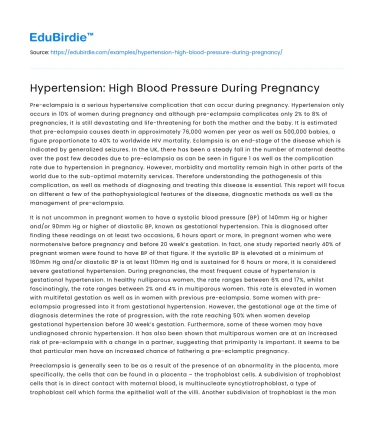Pre-eclampsia is a serious hypertensive complication that can occur during pregnancy. Hypertension only occurs in 10% of women during pregnancy and although pre-eclampsia complicates only 2% to 8% of pregnancies, it is still devastating and life-threatening for both the mother and the baby. It is estimated that pre-eclampsia causes death in approximately 76,000 women per year as well as 500,000 babies, a figure proportionate to 40% to worldwide HIV mortality. Eclampsia is an end-stage of the disease which is indicated by generalized seizures. In the UK, there has been a steady fall in the number of maternal deaths over the past few decades due to pre-eclampsia as can be seen in figure 1 as well as the complication rate due to hypertension in pregnancy. However, morbidity and mortality remain high in other parts of the world due to the sub-optimal maternity services. Therefore understanding the pathogenesis of this complication, as well as methods of diagnosing and treating this disease is essential. This report will focus on different a few of the pathophysiological features of the disease, diagnostic methods as well as the management of pre-eclampsia.
It is not uncommon in pregnant women to have a systolic blood pressure (BP) of 140mm Hg or higher and/or 90mm Hg or higher of diastolic BP, known as gestational hypertension. This is diagnosed after finding these readings on at least two occasions, 6 hours apart or more, in pregnant women who were normotensive before pregnancy and before 20 week’s gestation. In fact, one study reported nearly 40% of pregnant women were found to have BP of that figure. If the systolic BP is elevated at a minimum of 160mm Hg and/or diastolic BP is at least 110mm Hg and is sustained for 6 hours or more, it is considered severe gestational hypertension. During pregnancies, the most frequent cause of hypertension is gestational hypertension. In healthy nulliparous women, the rate ranges between 6% and 17%, whilst fascinatingly, the rate ranges between 2% and 4% in multiparous women. This rate is elevated in women with multifetal gestation as well as in women with previous pre-eclampsia. Some women with pre-eclampsia progressed into it from gestational hypertension. However, the gestational age at the time of diagnosis determines the rate of progression, with the rate reaching 50% when women develop gestational hypertension before 30 week’s gestation. Furthermore, some of these women may have undiagnosed chronic hypertension. It has also been shown that multiparous women are at an increased risk of pre-eclampsia with a change in a partner, suggesting that primiparity is important. It seems to be that particular men have an increased chance of fathering a pre-eclamptic pregnancy.
Save your time!
We can take care of your essay
- Proper editing and formatting
- Free revision, title page, and bibliography
- Flexible prices and money-back guarantee
Preeclampsia is generally seen to be as a result of the presence of an abnormality in the placenta, more specifically, the cells that can be found in a placenta – the trophoblast cells. A subdivision of trophoblast cells that is in direct contact with maternal blood, is multinucleate syncytiotrophoblast, a type of trophoblast cell which forms the epithelial wall of the villi. Another subdivision of trophoblast is the mononuclear extravillous cytotrophoblast; this forms the decidua, which is defined as the tissue interface found within the uterus lining. The clinical manifestation is simply due to maternal endothelial dysfunction which in turn causes the systemic circulatory disturbances that patients present with. Two vast categories will be explored: placental and maternal preeclampsia. The main issue that emerges in placental pre-eclampsia, is due to the placenta being under hypoxic conditions with oxidative stress.
General malaise, convulsions, or abdominal pain are some of the symptoms some women present with, however, the most commonly used diagnostic sign is hypertension. As the is a lack of diagnostic investigations specifically for pre-eclampsia, the initial diagnosis is based on clinical features. The severity of pre-eclampsia is mainly defined based on the patient’s blood pressure value along with the presence of proteinuria; any other characterizations are based on associated symptoms.
The method of measuring blood pressure during pregnancy had been under much debate. Until the late 1990s, Korotkoff phase IV (muffling of sound) was used instead of Korotkoff phase V (disappearance of sound) because, in some pregnant women, the sounds do not disappear. A randomised controlled trial comparing the results in hypertensive disorders in pregnancy managed based on either methods was published by The Lancet in 1998 demonstrated that an episode of severe hypertension was more likely to be present by a patient in the Korotkoff phase IV as it was more likely than diastolic hypertension would have been recorded. Nevertheless, the occurrence of severe hypertension, concurrent systolic and diastolic hypertension as well as detrimental maternal and foetal clinical result showed no discrepancy between the two methods. Consequently, after examining these results and considering that Korotkoff phase V is a better indication of intra-arterial pressure as well as being far more reproducible, the use Korotkoff phase V to classify diastolic BP was suggested and since has been implemented and used by the UK.
When measuring BP, the patient should be rested and reclined at an angle of 45. The blood pressure cuff should be a suitable size and placed at the same level as the patient’s heart. Due to many discrepancies in normal BP, numerous readings should be taken to confirm a diagnosis.
The changes in pre-eclampsia is generally the opposite of that of a normal pregnancy, as normal pregnancies usually have a considerable change in BP, with a 50% increase in blood volume as well as cardiac output, frequently accompanied by a fall in BP as a result of peripheral vasodilation.






 Stuck on your essay?
Stuck on your essay?

